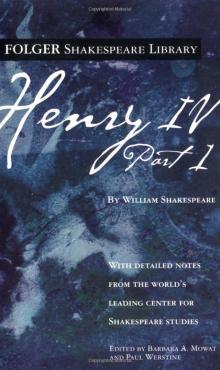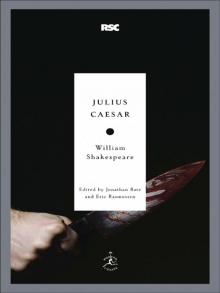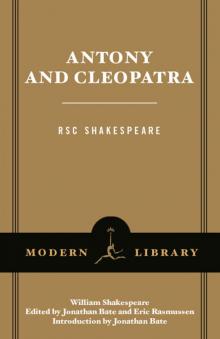- Home
- William Shakespeare
The Merchant of Venice Page 2
The Merchant of Venice Read online
Page 2
“The quality of mercy is not strained”: the quality of Portia’s argument (and Shakespeare’s writing) unfolds from the several meanings of “strained.” Mercy is not constrained or forced, it must be freely given; nor is it partial or selective—it is a pure distillation like “the gentle rain from heaven,” not the kind of liquid from which impure particles can be strained out. As in Measure for Measure, Shakespeare explores the tension between justice and mercy, here interpreted in terms of the opposition between the Old Testament Jewish law of “an eye for an eye” and Christ’s New Testament covenant of forgiveness. When Shylock refuses to show mercy and stands by the old covenant, Portia’s art is to throw his legal literalism back in his face: the corollary of his demand for an exact pound of flesh is that he should not spill a drop of Venetian blood. But if the quality of mercy is not strained, then neither should be that of conversion: a bitter taste is left when Shylock is constrained to become a Christian.
“… AND WHICH THE JEW?”
Commerce, with which Venice was synonymous, depends on borrowing to raise capital. Christianity, however, disapproved of usury, the lending of money with interest. The Jewish moneylender was early modern Europe’s way out of this impasse. Venice was famous for its ghetto in which the Jews were constrained to live, even as they oiled the wheels of the city’s economy. Shakespeare does not mention the ghetto, but he reveals a clear understanding of how the system worked when Shylock refuses Antonio’s invitation to dinner: “I will buy with you, sell with you, talk with you, walk with you, and so following, but I will not eat with you, drink with you, nor pray with you.” There is sociability and commerce between different ethnic and religious groups, but spiritual practices and customs are kept distinct. Shylock will not go to dinner because his religion prevents him from eating pork, but ultimately he regards questions of business as more important than those of faith: he hates Antonio “for he is a Christian, / But more, for that in low simplicity / He lends out money gratis and brings down / The rate of usance here with us in Venice.”
The historical reality in the age of Shakespeare was that Christians did lend money to each other with interest, while Judaic law as well as Christian frowned upon extortion. What one person regards as immoral exploitation another may regard as legitimate business practice. Shylock makes exactly this point when referring to “my bargains and my well-won thrift, / Which he [Antonio] calls interest.” There are Christian usurers in other plays of the time. Besides, Shylock does not charge interest on the three thousand ducats he lends Antonio: instead, he takes out a bond, albeit of a rather unusual kind, as his insurance policy. One of the play’s key puns, alongside those on terms that are both commercial and emotional such as “dear” and “bond,” is “rate,” which in the dialogue between Bassanio and Shylock about Antonio refers first to the question of interest rates and then to berating in the sense of abuse. The berating of Jew by Christian, and vice versa, is a screen for the real issue, which is the question of who has money and hence power (including the power to win a wealthy, clever, and beautiful wife).
We should therefore be wary of crude generalizations about the anti-Semitism of the play or of the age. It is often said that the original stage Shylock would have had a wig of red hair and a long bottle-like nose, making him into a stereotypical Jew. He was certainly represented thus when the play was revived after the theaters reopened following the Restoration of the monarchy in 1660, but there is no evidence that this is how he looked in Shakespeare’s own theater. Portia’s line on arriving in the courtroom, “Which is the merchant here, and which the Jew?,” suggests that in terms of superficial appearance Antonio and Shylock are not readily distinguishable. It is not easily compatible with a caricature Jew. Nor does the dialogue at any point allude to the anti-Semitic propaganda that has defiled the centuries. There are no allusions to the story of Hugh of Lincoln, to poisoning wells, desecrating the host, ritual murder, crucified children. Shylock speaks of his “sacred nation,” but no one replies with the old anti-Semitic accusation that the Jews are to be hated because they murdered Christ. There are, then, different degrees of prejudice in the play, just as there were different degrees of respect and disrespect for Jews in Shakespeare’s Europe. Some, but not all, of the Christians in the play spit upon Shylock simply because he is a Jew. They are the same Christians who don’t spend much time going to church, giving money to the poor, or turning the other cheek.
Barabas, the Jew of Malta in the play written by Marlowe a few years before, answers to the stereotype of the Jew in love with his moneybags (though he does also love his daughter), whereas Shylock famously appeals to a common humanity that extends across the ethnic divide:
He hath disgraced me, and hindered me half a million, laughed at my losses, mocked at my gains, scorned my nation, thwarted my bargains, cooled my friends, heated mine enemies, and what’s the reason? I am a Jew. Hath not a Jew eyes? Hath not a Jew hands, organs, dimensions, senses, affections, passions? Fed with the same food, hurt with the same weapons, subject to the same diseases, healed by the same means, warmed and cooled by the same winter and summer, as a Christian is? If you prick us, do we not bleed? If you tickle us, do we not laugh? If you poison us, do we not die?
In Elizabethan England the test for a witch was the pricking of her thumb: if it did not bleed, the woman was in league with the devil. Shylock’s “If you prick us, do we not bleed” is a way of saying “do not demonize the Jews—we are not like witches.” “The villainy you teach me I will execute,” he continues: if you do demonize me, then I will behave diabolically. The alien, the oppressed minority, sees no alternative but to fight back: “And if you wrong us, shall we not revenge?” This is the point of parting between the Jewish law of “an eye for an eye” and the Christian notion of turning the other cheek and showing the quality of mercy. The consequence of Shylock’s insistence on the law of revenge, his failure to show mercy when Portia gives him the opportunity to do so, is his forced conversion. This sticks in the throat of the modern audience because it shows a lack of respect for religious difference, but for most of Shakespeare’s original audience it would have seemed like an act of mercy. Despite his willingness to murder Antonio, he is still given the opportunity of salvation.
The representation of Shylock as monstrous villain has played a part in the appalling history of European anti-Semitism. But such a representation necessarily occludes the subtler moments of Shakespeare’s characterization. A ring is not only the device whereby Portia and Nerissa assert their moral and verbal superiority over their husbands, but also the means by which Shylock is humanized:
TUBAL One of them showed me a ring that he had of your daughter for a monkey.
SHYLOCK Out upon her! Thou torturest me, Tubal. It was my turquoise, I had it of Leah when I was a bachelor. I would not have given it for a wilderness of monkeys.
The role of Shylock has been a gift to great actors down the ages because it gives them the opportunity not only to rage and to be outrageous, but also to turn the mood in an instant, to be suddenly quiet and hurt and sorrowful. When Shylock gleefully whets his knife in the trial scene, he presents the very image of a torturer. But he is tortured himself, simply through the memory of a girl called Leah whom he loved and married, and who bore his daughter (who has deserted both him and his faith) and who died and of whom all that remained was a ring that he would not have given for a wilderness of monkeys.
* “The Argument of Comedy” originally appeared in English Institute Essays 1948, ed. D. A. Robertson (1949), and has often been reprinted in critical anthologies. Frye himself adapted it for inclusion in his classic study, Anatomy of Criticism (1957).
ABOUT THE TEXT
Shakespeare endures through history. He illuminates later times as well as his own. He helps us to understand the human condition. But he cannot do this without a good text of the plays. Without editions there would be no Shakespeare. That is why every twenty years or so throughout the last three centuries there
has been a major new edition of his complete works. One aspect of editing is the process of keeping the texts up to date—modernizing the spelling, punctuation, and typography (though not, of course, the actual words), providing explanatory notes in the light of changing educational practices (a generation ago, most of Shakespeare’s classical and biblical allusions could be assumed to be generally understood, but now they can’t).
Because Shakespeare did not personally oversee the publication of his plays, with some plays there are major editorial difficulties. Decisions have to be made as to the relative authority of the early printed editions, the pocket format “quartos” published in Shakespeare’s lifetime and the elaborately produced “First Folio” text of 1623, the original “Complete Works” prepared for the press after his death by Shakespeare’s fellow actors, the people who knew the plays better than anyone else.
The Merchant of Venice is one of three comedies where the Folio text was printed from a marked-up copy of a First Quarto (the others are Love’s Labour’s Lost and Much Ado About Nothing). The standard procedure for the modern editor is to use the First Quarto as the copy text but to import stage directions, act divisions, and some corrections from Folio. Our Folio-led policy means that we follow the reverse procedure, using Folio as copy text, but deploying the First Quarto as a “control text” that offers assistance in the correction and identification of compositors’ errors. Differences are for the most part minor.
The following notes highlight various aspects of the editorial process and indicate conventions used in the text of this edition:
Lists of Parts are supplied in the First Folio for only six plays, not including The Merchant of Venice, so the list here is editorially supplied. Capitals indicate that part of the name which is used for speech headings in the script (thus “Prince of ARAGON, suitor to Portia”).
Locations are provided by the Folio for only two plays, of which The Merchant of Venice is not one. Eighteenth-century editors, working in an age of elaborately realistic stage sets, were the first to provide detailed locations (“another part of the city”). Given that Shakespeare wrote for a bare stage and often an imprecise sense of place, we have relegated locations to the explanatory notes at the foot of the page, where they are given at the beginning of each scene where the imaginary location is different from the one before. In the case of The Merchant of Venice, the action is divided between Venice and Portia’s country estate of Belmont.
Act and Scene Divisions were provided in the Folio in a much more thoroughgoing way than in the Quartos. Sometimes, however, they were erroneous or omitted; corrections and additions supplied by editorial tradition are indicated by square brackets. Five-act division is based on a classical model, and act breaks provided the opportunity to replace the candles in the indoor Blackfriars playhouse which the King’s Men used after 1608, but Shakespeare did not necessarily think in terms of a five-part structure of dramatic composition. The Folio convention is that a scene ends when the stage is empty. Nowadays, partly under the influence of film, we tend to consider a scene to be a dramatic unit that ends with either a change of imaginary location or a significant passage of time within the narrative. Shakespeare’s fluidity of composition accords well with this convention, so in addition to act and scene numbers we provide a running scene count in the right margin at the beginning of each new scene, in the typeface used for editorial directions. Where there is a scene break caused by a momentary bare stage, but the location does not change and extra time does not pass, we use the convention running scene continues. There is inevitably a degree of editorial judgment in making such calls, but the system is very valuable in suggesting the pace of the plays.
Speakers’ Names are often inconsistent in Folio. We have regularized speech headings, but retained an element of deliberate inconsistency in entry directions, in order to give the flavor of Folio. Thus LANCELET is always so-called in his speech headings, but is “Clown” in entry directions.
Verse is indicated by lines that do not run to the right margin and by capitalization of each line. The Folio printers sometimes set verse as prose, and vice versa (either out of misunderstanding or for reasons of space). We have silently corrected in such cases, although in some instances there is ambiguity, in which case we have leaned toward the preservation of Folio layout. Folio sometimes uses contraction (“turnd” rather than “turned”) to indicate whether or not the final “-ed” of a past participle is sounded, an area where there is variation for the sake of the five-beat iambic pentameter rhythm. We use the convention of a grave accent to indicate sounding (thus “turnèd” would be two syllables), but would urge actors not to overstress. In cases where one speaker ends with a verse half line and the next begins with the other half of the pentameter, editors since the late eighteenth century have indented the second line. We have abandoned this convention, since the Folio does not use it, nor did actors’ cues in the Shakespearean theater. An exception is made when the second speaker actively interrupts or completes the first speaker’s sentence.
Spelling is modernized, but older forms are very occasionally maintained where necessary for rhythm or aural effect.
Punctuation in Shakespeare’s time was as much rhetorical as grammatical. “Colon” was originally a term for a unit of thought in an argument. The semicolon was a new unit of punctuation (some of the Quartos lack them altogether). We have modernized punctuation throughout, but have given more weight to Folio punctuation than many editors, since, though not Shakespearean, it reflects the usage of his period. In particular, we have used the colon far more than many editors: it is exceptionally useful as a way of indicating how many Shakespearean speeches unfold clause by clause in a developing argument that gives the illusion of enacting the process of thinking in the moment. We have also kept in mind the origin of punctuation in classical times as a way of assisting the actor and orator: the comma suggests the briefest of pauses for breath, the colon a middling one, and a full stop or period a longer pause. Semi-colons, by contrast, belong to an era of punctuation that was only just coming in during Shakespeare’s time and that is coming to an end now: we have accordingly only used them where they occur in our copy texts (and not always then). Dashes are sometimes used for parenthetical interjections where the Folio has brackets. They are also used for interruptions and changes in train of thought. Where a change of addressee occurs within a speech, we have used a dash preceded by a period (or occasionally another form of punctuation). Often the identity of the respective addressees is obvious from the context. When it is not, this has been indicated in a marginal stage direction.
Entrances and Exits are fairly thorough in Folio, which has accordingly been followed as faithfully as possible. Where characters are omitted or corrections are necessary, this is indicated by square brackets (e.g. “[and Attendants]”). Exit is sometimes silently normalized to Exeunt and Manet anglicized to “remains.” We trust Folio positioning of entrances and exits to a greater degree than most editors.
Editorial Stage Directions such as stage business, asides, indications of addressee and of characters’ position on the gallery stage are only used sparingly in Folio. Other editions mingle directions of this kind with original Folio and Quarto directions, sometimes marking them by means of square brackets. We have sought to distinguish what could be described as directorial interventions of this kind from Folio-style directions (either original or supplied) by placing them in the right margin in a different typeface. There is a degree of subjectivity about which directions are of which kind, but the procedure is intended as a reminder to the reader and the actor that Shakespearean stage directions are often dependent upon editorial inference alone and are not set in stone. We also depart from editorial tradition in sometimes admitting uncertainty and thus printing permissive stage directions, such as an Aside? (often a line may be equally effective as an aside or as a direct address—it is for each production or reading to make its own decision) or a may exit or a piece of business placed be
tween arrows to indicate that it may occur at various different moments within a scene.
Line Numbers in the left margin are editorial, for reference and to key the explanatory and textual notes.
Explanatory Notes at the foot of each page explain allusions and gloss obsolete and difficult words, confusing phraseology, occasional major textual cruces, and so on. Particular attention is given to non-standard usage, bawdy innuendo, and technical terms (e.g. legal and military language). Where more than one sense is given, commas indicate shades of related meaning, slashes alternative or double meanings.
Textual Notes at the end of the play indicate major departures from the Folio. They take the following form: the reading of our text is given in bold and its source given after an equals sign, with “Q” indicating a Quarto reading, Q2 a reading from the Second Quarto of 1619, “F2” a reading from the Second Folio of 1632, and “Ed” one that derives from the subsequent editorial tradition. The rejected Folio (“F”) reading is then given. Thus for Act 2 Scene 9 line 45: “peasantry = Q. F = pleasantry” means that the Folio text’s “pleasantry” has been rejected in favor of the Quarto reading “peasantry,” which seems to make better sense of the line.
KEY FACTS
MAJOR PARTS: (with percentage of lines/number of speeches/scenes on stage) Portia (22%/117/9), Shylock (13%/79/5), Bassanio (13%/73/6), Gratiano (7%/58/7), Lorenzo (7%/47/7), Antonio (7%/47/6), Lancelet Gobbo (6%/44/6), Salerio (5%/31/7), Morocco (4%/7/2), Nerissa (3%/36/7), Jessica (3%/26/7), Solanio (2%/20/5), Duke (2%/18/1), Aragon (2%/4/1), Old Gobbo (1%/19/1).

 Romeo and Juliet
Romeo and Juliet As You Like It (Folger Shakespeare Library)
As You Like It (Folger Shakespeare Library) Hamlet
Hamlet Richard II (Folger Shakespeare Library)
Richard II (Folger Shakespeare Library) Macbeth
Macbeth Henry V
Henry V The Winter's Tale
The Winter's Tale The Taming of the Shrew
The Taming of the Shrew The Comedy of Errors
The Comedy of Errors King Lear (Folger Shakespeare Library)
King Lear (Folger Shakespeare Library) Twelfth Night
Twelfth Night Othello
Othello The Two Gentlemen of Verona
The Two Gentlemen of Verona Henry IV, Part 1 (Folger Shakespeare Library)
Henry IV, Part 1 (Folger Shakespeare Library) King John/Henry VIII (Signet Classics)
King John/Henry VIII (Signet Classics) The Tempest
The Tempest Titus Andronicus (Dover Publications)
Titus Andronicus (Dover Publications) A Midsummer Night's Dream
A Midsummer Night's Dream Antony and Cleopatra (Arden Shakespeare: Third Series)
Antony and Cleopatra (Arden Shakespeare: Third Series) The Oxford Shakespeare: Henry IV, Part 2 (Oxford World's Classics)
The Oxford Shakespeare: Henry IV, Part 2 (Oxford World's Classics) Much Ado About Nothing (Arden Shakespeare: Third Series)
Much Ado About Nothing (Arden Shakespeare: Third Series) All's Well That Ends Well
All's Well That Ends Well Titus Andronicus & Timon of Athens
Titus Andronicus & Timon of Athens Richard III (Modern Library Classics)
Richard III (Modern Library Classics) Coriolanus
Coriolanus srsly Hamlet (OMG Shakespeare)
srsly Hamlet (OMG Shakespeare) The Merchant of Venice
The Merchant of Venice Richard III
Richard III Richard II
Richard II Pericles
Pericles As You Like It
As You Like It Cymbeline
Cymbeline Alls Wel that ends Well
Alls Wel that ends Well YOLO Juliet
YOLO Juliet A Midsummer Night #nofilter
A Midsummer Night #nofilter Love's Labour's Lost
Love's Labour's Lost Much Ado About Nothing
Much Ado About Nothing Romeo & Juliet & Vampires
Romeo & Juliet & Vampires The Arden Shakespeare Complete Works
The Arden Shakespeare Complete Works Julius Caesar
Julius Caesar Five Revenge Tragedies: The Spanish Tragedy, Hamlet, Antonio's Revenge, The Tragedy of Hoffman, The Revenger's Tragedy (Penguin Classics)
Five Revenge Tragedies: The Spanish Tragedy, Hamlet, Antonio's Revenge, The Tragedy of Hoffman, The Revenger's Tragedy (Penguin Classics) Macbeth #killingit
Macbeth #killingit The Oxford Shakespeare: The Complete Works
The Oxford Shakespeare: The Complete Works Hamlet, Prince of Denmark (Collins edition)
Hamlet, Prince of Denmark (Collins edition) King John & Henry VIII
King John & Henry VIII Henry IV, Part 2
Henry IV, Part 2 Complete Plays, The
Complete Plays, The The Sonnets and Other Poems
The Sonnets and Other Poems Antony and Cleopatra
Antony and Cleopatra Henry IV, Part 1
Henry IV, Part 1 Is This a Dagger Which I See Before Me?
Is This a Dagger Which I See Before Me? The Complete Works of William Shakespeare In Plain and Simple English (Translated)
The Complete Works of William Shakespeare In Plain and Simple English (Translated) The Sonnets
The Sonnets